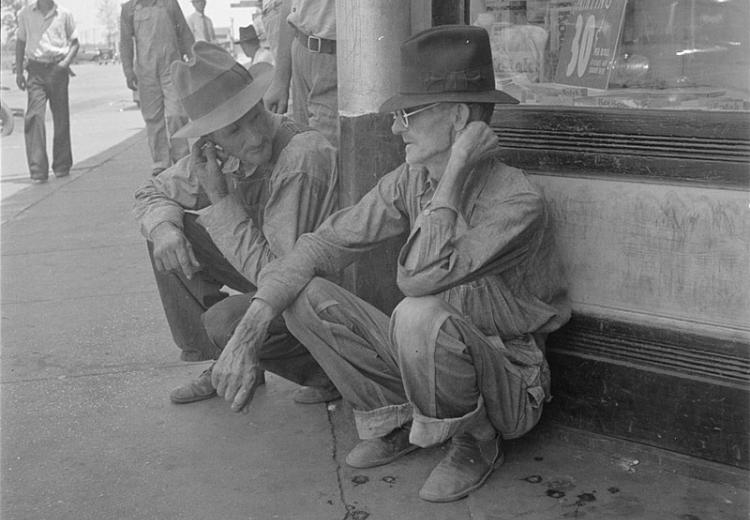John Steinbeck’s The Grapes of Wrath: Verbal Pictures

Drought farmers line the shady side of the main street of the town while their crops burn up in the fields. "The guvment may keep us a little I reckon." Sallisaw, Oklahoma. Dorothea Lange: August 1936
"Steinbeck’s conscious and unconscious borrowings, echoes, and reverberations throughout The Grapes of Wrath came from a constellation of artistic, social and intellectual sources so varied no single reckoning can do them justice."
— Robert DeMott, Introduction, Working Days
The historical record of John Steinbeck’s working method that culminated in The Grapes of Wrath includes his accounts of the migrants in the camps gathered through his fieldwork and accompanied by photographic documentation by Dorothea Lange and other national photojournalists. These observations found expression in Steinbeck’s The Harvest Gypsies series of news articles which served as a seedbed for The Grapes of Wrath. Steinbeck also kept a personal journal with daily entries during the writing of The Grapes of Wrath, later published as Working Days. An examination of The Harvest Gypsies and Working Days provides valuable insight into the author’s mindset and vision as he composed the novel.
In this lesson, students will study the sources of visual images that influenced Steinbeck’s writing in The Grapes of Wrath and its precursors. They will examine Dorothea Lange Farm Security Administration (FSA) photographs from the 1930s and trace Steinbeck’s method of drawing upon and further honing such images into pictorial prose through the “crucible of his imagination.” Students will then analyze and interpret the role the imagery based upon these verbal pictures plays in key passages within The Grapes of Wrath.
Guiding Questions
How does Steinbeck translate his impressions of 1930s Farm Security Administration photographs into journalistic and then literary pictorial prose?
How do Steinbeck’s “verbal pictures” enhance other literary elements to infuse life into The Grapes of Wrath?
Learning Objectives
Compare FSA photographs of 1930s Dust Bowl migrants and Steinbeck’s pictorial prose in nonfiction journal articles, personal diary entries, and The Grapes of Wrath narrative.
Analyze and interpret how Steinbeck uses a photographic image as a major symbolic element in his novel, The Grapes of Wrath.
